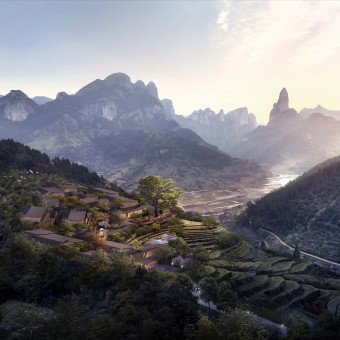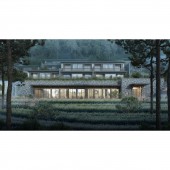Banyan Tree Xianju Resort Hotel by Kaijian Zhang - gad |
Home > Winners > #135898 |
 |
|
||||
| DESIGN DETAILS | |||||
| DESIGN NAME: Banyan Tree Xianju Resort PRIMARY FUNCTION: Hotel INSPIRATION: The plot has prominent landscape resource advantages and rich cultural deposits. The design aims to make flexible use of the complex terrain of the original site of Lishan Village, based on the architectural forms and elements of traditional mountain villages in Zhejiang, combined with modern technology and local materials, to create a wild, simple and quiet atmosphere of the park. Public area is placed under the mountain body combined with the old stone wall, the guest rooms are placed above public area and presented in the form of a settlement, evoking the memory of the ancient village. UNIQUE PROPERTIES / PROJECT DESCRIPTION: Lishan Village, located at the east foot of Wujia Mountain in Xianju County, Taizhou City, Zhejiang Province, has an excellent location overlooking the Shenxianju scenic spot. The architectural style of the design is intended to show the collision and integration of traditional landscape and modern elements. The all-glass facade of the public space ensures the best landscape presentation. The guest room of Villa takes the original local ecological village as its theme, trees and winding paths. OPERATION / FLOW / INTERACTION: The project is divided into four buildings, among which building 1, 2 and 4 are composed of public areas and guest rooms, while building 3, is all guest rooms. Public areas and logistics are located in the lower area, while guest rooms are located in the higher area, ensuring the independence of various traffic lines. The building is high in the north and low in the south, the public spaces combined with the original village form are placed under the wall. PROJECT DURATION AND LOCATION: The project started in 2019 in Danzhu Township, Xianju County, Taizhou City, Zhejiang Province, China and finished in 2021, and will establish in 2023. FITS BEST INTO CATEGORY: Architecture, Building and Structure Design |
PRODUCTION / REALIZATION TECHNOLOGY: Vernacular architecture seems to be born organic. They appropriated natural forms and structures and was simply built with local materials. Further, vernacular architecture is part of the process of human survival, reproduction and continuity of life. It is closely linked to the land and to the human spirit. In the selection of materials for the building, we have given preference to organic materials. The stones of the "Old Parapet" in the original village were reapplied as a finish to the base. SPECIFICATIONS / TECHNICAL PROPERTIES: The architectural style of the design is intended to show the collision and integration of traditional landscape and modern elements. The all-glass facade of the public space ensures the best landscape presentation. The guest room of Villa takes the original local ecological village as its theme, trees and winding paths. TAGS: New Chinese Style, Resort Hotel RESEARCH ABSTRACT: Xianju County is the "Home of Hundreds of Crafts" and has a great deal of intangible cultural heritage. The question of how the architecture should reflect the character of the region is the first question we considered. Vernacular architecture seems to be born organic. They appropriated natural forms and structures and was simply built with local materials. Further, vernacular architecture is part of the process of human survival, reproduction and continuity of life. It is closely linked to the land and to the human spirit. In the selection of materials for the building, we have given preference to organic materials (the durability of different types of organic materials has been deliberated for the sake of the subsequent maintenance of the hotel). The stones of the "Old Parapet" in the original village were reapplied as a finish to the base. This is a blend of old and new architecture, giving the hotel a new spiritual meaning. CHALLENGE: The design gives full consideration to the use of the surrounding landscape. The building is high in the north and low in the south, ensuring that all guestrooms and public Spaces have a view of the main scenery of the old camphor tree, terrace and Shenxianju. The overall layout follows the principle of combining nature, and the building is scattered according to the mountain. The public spaces are designed as a landscape building that respects the context. Villa rooms, modeled on villages, are orderly scattered over public spaces, integrating with mountains, terraced fields and springs. ADDED DATE: 2022-02-16 04:16:04 TEAM MEMBERS (17) : Project Director: Kaijian Zhang, Other Team Members: Xuan Wu, Lu Zhang, Zi'ang Liu, Guangzhao Chen, Ying Li, Yingyao Wu, Zuhang Zhuo, Maoqing Shao, Zhenhuan Zhang, Electrical: Shanghai Baiheng Electromechanical Design Office Co., Ltd., Interior: Yang Bangsheng Design Group, Landscape: Tourism Design (Shenzhen) priority design, KKSIC-Kanko Designers & Associates Co., Ltd., Kitchen: Shanghai Newray Kitchen Consultant Co., Ltd., Hotel Management: Banyan Tree Holding Company Limited and Rendering: Tongchuang IMAGE CREDITS: Image #1: Rendering Tongchuang, Main image, 2021. Image #2: Rendering Tongchuang, Lobby facade, 2021. Image #3: Rendering Tongchuang, All day dining restaurant Facade, 2021. Image #4: Rendering Tongchuang, Chinese restaurant Facade, 2021. Image #5: Rendering Tongchuang, Bird view, 2020. |
||||
| Visit the following page to learn more: http://www.gad.com.cn/index.php | |||||
| AWARD DETAILS | |
 |
Banyan Tree Xianju Resort Hotel by Kaijian Zhang-Gad is Winner in Architecture, Building and Structure Design Category, 2021 - 2022.· Read the interview with designer Kaijian Zhang - gad for design Banyan Tree Xianju Resort here.· Press Members: Login or Register to request an exclusive interview with Kaijian Zhang - gad. · Click here to register inorder to view the profile and other works by Kaijian Zhang - gad. |
| SOCIAL |
| + Add to Likes / Favorites | Send to My Email | Comment | Testimonials | View Press-Release | Press Kit |
Did you like Kaijian Zhang-Gad's Architecture Design?
You will most likely enjoy other award winning architecture design as well.
Click here to view more Award Winning Architecture Design.








